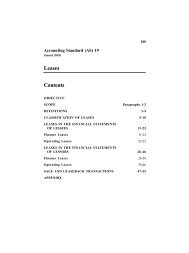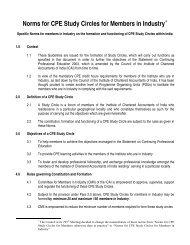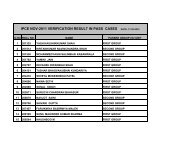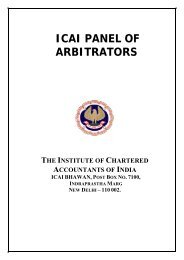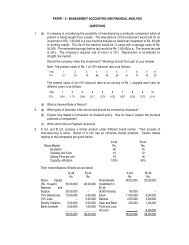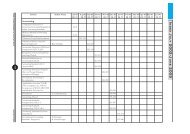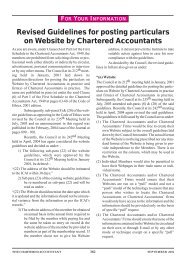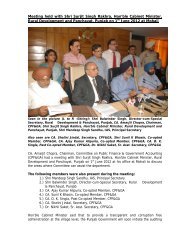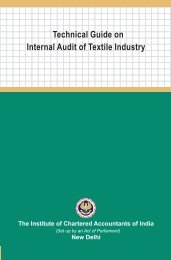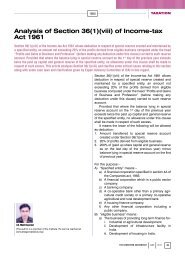The Chartered Accountant
The Chartered Accountant
The Chartered Accountant
Create successful ePaper yourself
Turn your PDF publications into a flip-book with our unique Google optimized e-Paper software.
DECEMBER 2008 1010 THE CHARTERED ACCOUNTANT<br />
GLOBAL PERSPECTIVE<br />
India has an opportunity to learn from America’s mistakes. It should develop<br />
secondary markets carefully and thoughtfully, with appropriate regulation,<br />
infrastructure, and disclosure requirements. In the primary market, lenders<br />
must monitor borrowers’ credit histories and track credit scores. India has<br />
already experienced some of America’s problems.<br />
bought home mortgages from local banks and mortgage<br />
originators, picking mortgages based on computerized<br />
programs that modeled risk levels. Investments<br />
banks took mortgages from various parts of<br />
the United States to mitigate the risk; the theory being<br />
that even if one area became depressed the other regions<br />
would still be good investments. <strong>The</strong> models<br />
became even more sophisticated over time, mixing<br />
and matching mortgages from certain cities, neighborhoods,<br />
types and lengths of mortgages, types of<br />
homes, and prices of homes. <strong>The</strong> investment banks<br />
aggregated the mortgages and then repackaged them<br />
into Special Purpose Entities (SPEs)—such as Collateralized<br />
Mortgage Obligations (CMOs) and Collateralized<br />
Debt Obligations (CDOs)—that varied in<br />
risk level. <strong>The</strong> SPE then sold classes or tranches of its<br />
securities to investors.<br />
<strong>The</strong> investment banks hired credit rating agencies that<br />
used their own computer models to assess the risk<br />
of the securities in the SPE and then issued ratings.<br />
<strong>The</strong> safest tranches were rated AAA and had lower<br />
yields than tranches that bore more risk of default by<br />
homeowners. Investment banks made a small profit<br />
by selling the different tranches at a higher price than<br />
they paid for the mortgages, but these profits added<br />
up as the US mortgage market grew into trillions of<br />
dollars. From 2001 to 2006, as subprime mortgages<br />
took a larger percentage of all mortgages originated,<br />
investment banks securitized them as well. In 2005<br />
alone, 81% of subprime mortgages, or $507 billion,<br />
were securitized, the vast majority through subprime<br />
lenders or through investment banks. 13<br />
Over time, the investment banks started enhancing<br />
the safety of the securities they sold by insuring them<br />
or guaranteeing them. Investment banks that floated<br />
the SPEs wrote contracts guaranteeing to their investors<br />
that they would buy back securities issued by<br />
SPEs if the investors could not find a ready buyer<br />
for them. In addition, insurance companies, such as<br />
AIG and other institutions, offered new products that<br />
were designed to protect investors against default risk.<br />
<strong>The</strong>se insurance-like products were called Credit Default<br />
Swaps (CDS). In return for a regularly paid fee,<br />
the insurer would pay the buyer if the SPE (or any<br />
other covered entity and its debt) defaulted or had a<br />
significant credit event, such as a restructuring or severe<br />
downward change to its rating. Payment could<br />
be either physical or cash. In a physical settlement, the<br />
CDS seller paid the buyer the face value of the debt<br />
in exchange for the debt itself. In a cash settlement,<br />
the CDS seller paid the buyer the difference between<br />
the original value of the debt and the current value<br />
after the triggering event. CDS became wildly popular<br />
because buyers could hedge against risk without paying<br />
money upfront. Indices (such as the Dow Jones<br />
CDX) cropped up that expanded the CDS market and<br />
allowed freer and more liquid trading. 14 By some estimates<br />
about $75 trillion dollars of CDS contracts<br />
have been written. CDS were sold to insure against<br />
the risk of several entities, not just SPEs, and were<br />
bought and sold multiple times. In particular, the insurance<br />
giant AIG was, by some accounts, is said to<br />
have written CDS contracts worth $450 billion.<br />
Trillions of dollars in privately traded securities were<br />
generated in the last decade; all based on the value<br />
of US real estate. When the real estate market in the<br />
United States started declining and interest rates rose,<br />
home owners began defaulting on their loans. <strong>The</strong><br />
number of foreclosures hit 1.3 million in 2007, a steep<br />
75% increase from the year before, and there have<br />
been even more home foreclosures in 2008. When<br />
banks keep the loans that they make to homeowners,<br />
they often renegotiate terms with them to avoid foreclosure.<br />
However, with mortgages being sold to SPEs<br />
and GSEs, pooled with other mortgages, securitized,<br />
chopped up into tranches, and sold to investors thousands<br />
of miles away, renegotiating with homeowners<br />
is difficult if not impossible.<br />
<strong>The</strong> Crisis spreads<br />
It took nearly a year of falling home prices and subsequent<br />
mortgage defaults to leak into the larger economy.<br />
Lenders with a significant subprime loan portfolio<br />
were affected first. $56 billion New Century Financial<br />
Corporation, one of the largest subprime lenders in<br />
the United States, was one of the first banks to fail,<br />
13 Report and Recommendations by the Majority Staff of the Joint Economic Committee, “<strong>The</strong> Subprime Lending Crisis,” October 2007, p. 18.<br />
14 Mike Jakola, “Credit Default Swap Index Options,” Kellogg School of Management, Northwestern University, June 2, 2006, pp. 2-3.



